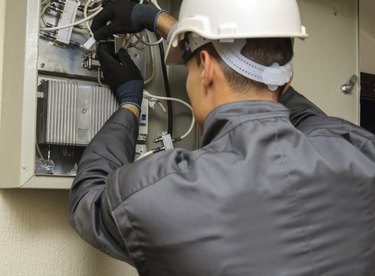
Simply put, a multiplexer is a device that combines the signals of two or more incoming lines onto a single outgoing line. A basic example of multiplexing is a telephone line, which carries many individual calls at the same time, with each call added to the line through multiplexing. Although most commonly associated with computing and communications, multiplexers have a variety of other applications.
MUX and DeMUX
Video of the Day
A multiplexer, or MUX, performs a selection process on two or more incoming signals using data from a control input to combine the incoming signals on one or more output lines. The combined output signal is transmitted; the receiving end must then separate the signals for processing.
Video of the Day
Separation of the combined signals is performed by a demultiplexor, or DeMUX. Using the telephone line example, when a call reaches its destination, it is separated from the combined line and forwarded on to its individual destination. This action could occur simultaneously for all of the signals on the carrier line or just one at a time.
Analog and Digital Multiplexers
There are analog and digital multiplexers. An analog MUX provides a means for multiple inputs to share a single output. An example of an analog MUX is the source selector on a stereo. By setting the dial to a particular input source, you -- the control input -- can select from a DVD player, AM/FM radio, tape player or a smartphone jack -- the inputs -- as the device with access to the speaker system, or the output.
A digital multiplexer uses control data to guide its actions. A digital MUX can have an even number -- such as two, four, six or more -- of inputs and one or a low even number of outputs. It also has control inputs, the number of which is based on how many inputs and outputs it has. A MUX with two inputs and one output needs only a single control input, while a MUX with 16 inputs and four outputs needs four control inputs for selecting the input lines and two control inputs for selecting which output line to use.
Multiplexer Uses
Digital multiplexers are used where multiple signals, or data, must be combined onto a single transmission line. This concept is widespread and common, and virtually every company involved with any form of data or voice transmission employs it at some level. In data communication, multiplexing increases the efficiency of the system by allowing the transmission of audio, video and data signals on the same carrier line. Voice communication systems, such as the telephone system, also gain efficiencies by multiplexing multiple call signals onto a single line.
Multiplexing Techniques and Protocols
A number of multiplexing techniques and protocols are in use on data and voice networks. The more common of these are Code-Division Multiplexing, or CDM; Frequency-Division Multiplexing, or FDM; Time-Division Multiplexing, or TDM; and Wavelength-Division Multiplexing, or WDM. CDM is a legacy data transmission technique; FDM is common to radio and TV broadcasting; and WDM is used for transmissions on fiber optic networks. Statistical multiplexing, a variation of TDM, is another method used for multiplexing multiple devices on a network.
- wiseGEEK: What Is a Multiplexer?
- Electronics Tutorials: The Multiplexer
- The Network Encyclopedia: Multiplexer (MUX)
- The TCP/IP Guide: TCP/IP Processes, Multiplexing and Client/Server Application Roles
- Sopto Technologies Co., Ltd: What is Multiplexing and Why is Multiplexing Needed in Data Communication?
- Tutorialspoint.com: DCN - Multiplexing